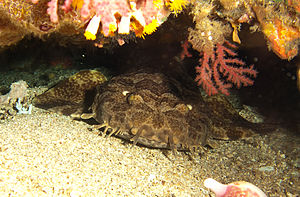Orectolobus leptolineatus
| Orectolobus leptolineatus | ||||||||||||
|---|---|---|---|---|---|---|---|---|---|---|---|---|

Orectolobus leptolineatus , underwater shot near Alor (Indonesia). |
||||||||||||
| Systematics | ||||||||||||
|
||||||||||||
| Scientific name | ||||||||||||
| Orectolobus leptolineatus | ||||||||||||
| Last , Pogonoski & White , 2010 |
Orectolobus leptolineatus is a species of fish from the family of carpet sharks (Orectolobidae) which occurs in the western Pacific in the coastal waters of central Indonesia , possibly also on the north coast of Borneo . The type specimens onwhich the first description is basedwere purchased at fish markets in Bali and Lombok . The type epithet leptolineatus refers to the fine pattern on its back ( size : "leptos" = fine, thin; Latin : "lineatus" = line).
Similar shark forms, possibly conspecific with Orectolobus leptolineatus , are also known from the Philippines ( Visayas and Cebu ), the Taiwanese Penghu Islands, and Okinawa .
features
Orectolobus leptolineatus is a medium-sized shark, the maximum length of which is estimated to be 1.2 meters. It differs from other types of carpet sharks mainly in its complex and variable coloration on the back and the sides of the body with changing dark and light brown bars, eye spots and saddles. The ventral side is evenly pale. The top of the paired fins shows a striking, worm-like intertwined pattern. The nasal barbels are branched. The numerous skin flaps that can be found mainly around the mouth also show a species-typical shape and complexity. The dorsal fins are large; the first begins above the base of the pelvic fin . The distance between the two dorsal fins corresponds to 0.5 to 0.8 times the length of the anal fin base. The inner edge of the anal fin is 0.7 to 0.8 times as long as its front edge. In the upper jaw there are 23 rows of teeth, a rudimentary teeth usually also on the upper jaw symphysis . The number of vertebrae is 148 to 163, of which 44 to 51 are monospondyle precudal vertebrae.
Way of life
Almost nothing is known about the way of life of Orectolobus leptolineatus . The specimens found at fish markets and used to describe the species were probably caught with longlines over deeper zones of the continental shelf, which is why it is assumed that the shark species prefers cooler deep water. There is a shallower water sighting from the east coast of Bali , in a region where cold deep water often rises.
All sexually mature males examined so far were about 90 cm long, the smallest sexually mature female 94 cm. Two pregnant females - all nurse sharks are viviparous - were 1.04 and 1.08 meters in length. The smaller of the two contained two embryos 13 and 14 cm in length.
annotation
- ↑ Monospondyle vertebrae are vertebrae with large vertebral bodies, one vertebral body per body segment , in contrast to diplospondylar vertebrae (two vertebrae per body segment).
literature
- Peter R. Last, JJ Pogonoski, WT White: A new wobbegong shark, Orectolobus leptolineatus sp. nov., from the western Central Pacific. In: PP Last, WT White, JJ Pogonoski (Ed.): Descriptions of new sharks and rays from Borneo. CSIRO Marine and Atmospheric Research Paper No. 32; Pages 1–16. ( Full text ; PDF; 7.6 MB)
Web links
- Orectolobus leptolineatus on Fishbase.org (English)